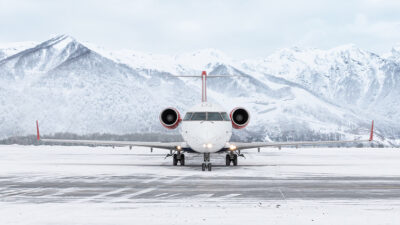Passenger Pressure

The vast quantity of knowledge that must be stuffed into a pilot’s head is just one reason only 0.2% of the U.S. population has at least a Private Pilot Certificate. As the ratings grow, the percentages decrease even further. There are a variety of reasons the pilot population is small and dwindling. Having the self-discipline to get all that knowledge into one brain through study, training and experience is daunting and costly. However, once you get paid to fly, it’s all worth it.
Even though pilots become proficient in their aviation skills, business aviation (bizav) pilots have another layer of challenges added to their resume: passenger skills. It’s not like an airline pilot where the sounds of voices and shuffled feet are as close as they come to passenger interactions.
Bizav pilots look their passengers in the eyes, and Part 91 flight departments have an even closer and confidential relationship with their passengers. They see them all the time and get to know them. Without realizing it, that personal relationship can affect decision-making.
The Shift From “If” to “Why”
As a pilot’s logbook grows and ratings are added to the certificate, there is a shift in perception due to experience and knowledge. The first few years of flying are spent trying to understand how to avoid adverse weather or airport challenges. But once you start getting paid to fly, pilots shift the thought process from avoidance of challenges to finding a way to complete the mission. The questions change from “if” to “how” and subliminally create a strong, mission-oriented mindset.
Especially in business aviation, you must learn how to deal with the weather and unfamiliar environments, operate in them, and find ways to the destinations (which are often unfamiliar airports) because someone is paying a lot of money for the privilege of being in a jet that can get to unusual locations. That person is sitting right behind you in the aircraft cabin, and you don’t want to let them down. That added pressure is blended with a bizav pilot’s thought process and mindset in moments of decision.
That mindset guides observable behaviors from minor actions to major decisions. From taking off too close to an inbound storm because you know the airport will be shutting down and the passengers must get to a wedding to touching down above ref because you want the boss to love your landing, pilots subconsciously behave to please. Their actions are guided by earned self-confidence, skill and previous outcomes.
Every pilot has continued an approach that wasn’t quite stable, but the outcome is often a perfect landing because the pilot corrected it along the way. It reinforces the mission mindset to complete the task at hand, even if it’s beyond parameters. That focus can become so narrow that options like going around are eliminated in the moment.
Yielding to Passenger Peer Pressure Can Lead to Bad Outcomes
Passenger peer pressure that isn’t properly addressed can increase the likelihood of negative outcomes in several ways. For example, pilots learn that a little extra airspeed makes for softer landings, and most of the time, they have extra runway. That pattern becomes established, and 99% of the time, it’s no problem. Then that same formula is applied to a contaminated or shorter runway, and that 20 knots above ref on the approach is the extra push it takes to have a runway excursion.
The irony is that most pilots know this, but in that tunnel vision of completing a task, options are forgotten. It takes a crew philosophy to use everyone’s piloting skills to full capacity. Pilots know what parameters/profile an aircraft should be in to continue an approach, so when the Pilot Monitoring sees the profile shifting, that pilot has the best opportunity to point out the situation and offer a solution without being insulting.
Honestly, many approaches begin outside the parameters of stabilized because ATC often has you too high, too fast, or too close to another aircraft (or they tell you someone is right behind you), and they leave it up to you to fix the problem after you’ve been cleared to land or cleared for the approach.
This is the moment where Pilot Monitoring should be pointing out those deviations. Give the Flying Pilot a moment to correct, but if the aircraft profile isn’t changing, speak louder and associate a solution. “We’re still ref plus 15, but we’re in flaps full or gear down range,” or something to that effect.
Sure, the Flying Pilot might be offended by the suggestion, but it will open their mind to possibilities, and pilots aren’t there to worry about offending someone. They’re there to get the aircraft on the ground safely and offend each other at the bar later.
Speak up.
Erika Armstrong is a business and commercial aviation captain. She flew 28 different aircraft before becoming an airline captain. She is also the Director of Marketing at Advanced Aircrew Academy. If you want to share your passenger pressure, she can be reached at Erika@achickinthecockpit.com

Advanced Aircrew Academy enables flight operations to fulfill their flight department training needs in the most efficient and affordable way – in any location at any time. We do this by providing high quality professional pilot, flight attendant, flight coordinator, maintenance, and line service modules delivered via the web using a world-class online aviation training system.
https://www.aircrewacademy.com/
© 2025 Advanced Aircrew Academy. All Rights Reserved.
Next ArticleRelated Posts

Mitigating Risk – Amidst the Chaos
There have been more high-profile aviation accidents in the last few months than in the last few decades. As we mourn those we have lost and aim not to make assumptions before final reports are completed, we must focus, personally and professionally, on assessing the risk of something similar happening within our aviation enterprises.

Let’s Get Personal (About Risk)
Aviation loves to talk about risk management. Insurance companies, manufacturers, and organizations all fully embrace the concept and know that to make it work on the line, we must get people at all levels and from all functional areas to embrace it. Tools such as the Flight Risk Assessment Tool (FRAT) are noble attempts, but at the core of it all lies the simple fact that people, as individuals, view risk differently.

